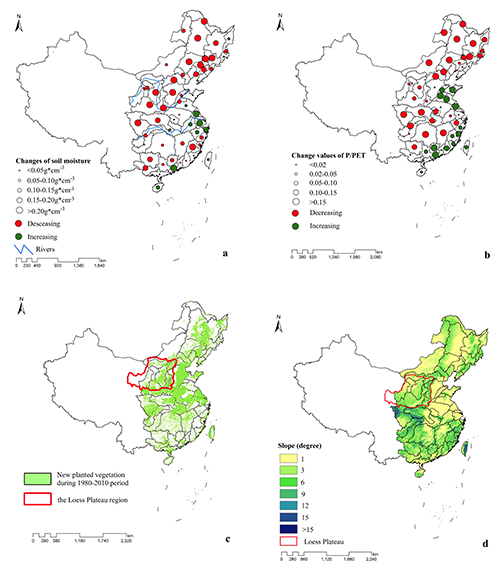Over the past few decades, several national-scale agricultural droughts have occurred in China. Research suggests that this kind of extreme droughts is expected to become more frequent and more severe in the future as a result of anthropogenic climate change. However, the causes of drought at the regional scale are not well understood and deserve further investigation.
Dr. Chen Xiuzhi from South China Botanical Garden, Chinese Academy of Sciences used the satellite-derived Essential Climate Variable Soil Moisture (ECV_SM) product to study the 32-year spatio-temporal variations of land surface soil moisture in China’s 80 drainage basins and investigate potential causations.
The spatial cluster of low soil moisture had spread from northwestern China to northeastern and even central China during the past 32 years. About 29 drainage basins in eastern China were estimated to have experienced significant reduction in soil moisture. The P/PET (ratio of precipitation to potential evapotranspiration), which showed highly consistent spatial pattern and temporal trend with the those of soil moisture, was believed to be the dominant factor in determining the temporal trends of soil moisture change. The areas of forest cover in the 29 drainage basins increased by 36.08% and the average topographic slope was twice steeper as steep as that of other regions. Besides the climate factor, land surface conditions (such as land cover changes and topographic slopes etc.) also played an important role in regulating the trend of regional soil moisture change.
It was worth noting that about 8 drainage basins in humid downstream of the Yangtze River and Pearl River basins showed significant increasing trends. That was perhaps because that reforestation had less effect on the regional water yield in humid regions (Zhou et al., 2015, Nature Communications). On the contrary, Forest might decrease the solar radiation, reduce the air temperature inside the forest and thereby reduce the evapotranspiration and finally increase the region’s water yield. This study provided evidences to support the “global pattern for the effect of climate and land cover on water yield” conducted by Zhou et al. (2015, Nature Communications).
Reference: Chen, X., Su, Y., Liao, J., Shang, J., Dong, T., Wang, C., ... & Liu, L. (2016). Detecting significant decreasing trends of land surface soil moisture in eastern China during the past three decades (1979–2010). Journal of Geophysical Research: Atmospheres. doi: 10.1002/2015JD024676.
(http://onlinelibrary.wiley.com/doi/10.1002/2015JD024676)

Temporal trends of soil moisture and PET, land cover changes and terrain slope
